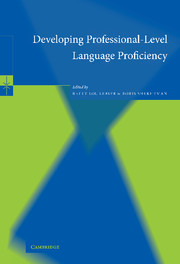Book contents
- Frontmatter
- Contents
- Notes on contributors
- Foreword
- Acknowledgments
- I Principles, practices, and theory
- II Programs
- 3 Contexts for advanced foreign language learning: a report on an immersion institute
- 4 Bridging the gap between language for general purposes and language for work: an intensive Superior-level language/skill course for teachers, translators, and interpreters
- 5 Learning Chinese in China: programs for developing Superior- to Distinguished-level Chinese language proficiency in China and Taiwan
- 6 Developing professional-level oral proficiency: the Shekhtman Method of Communicative teaching
- 7 The LangNet “Reading to the Four” Project: applied technology at higher levels of language learning
- 8 In the quest for the Level 4+ in Arabic: training Level 2–3 learners in independent reading
- 9 Teaching high-level writing skills in English at a Danish university
- 10 Heritage speakers as learners at the Superior level: differences and similarities between Spanish and Russian student populations
- 11 Teaching Russian language teachers in eight summer Institutes in Russian language and culture
- III Learners and users
- References
- Index
6 - Developing professional-level oral proficiency: the Shekhtman Method of Communicative teaching
Published online by Cambridge University Press: 03 December 2009
- Frontmatter
- Contents
- Notes on contributors
- Foreword
- Acknowledgments
- I Principles, practices, and theory
- II Programs
- 3 Contexts for advanced foreign language learning: a report on an immersion institute
- 4 Bridging the gap between language for general purposes and language for work: an intensive Superior-level language/skill course for teachers, translators, and interpreters
- 5 Learning Chinese in China: programs for developing Superior- to Distinguished-level Chinese language proficiency in China and Taiwan
- 6 Developing professional-level oral proficiency: the Shekhtman Method of Communicative teaching
- 7 The LangNet “Reading to the Four” Project: applied technology at higher levels of language learning
- 8 In the quest for the Level 4+ in Arabic: training Level 2–3 learners in independent reading
- 9 Teaching high-level writing skills in English at a Danish university
- 10 Heritage speakers as learners at the Superior level: differences and similarities between Spanish and Russian student populations
- 11 Teaching Russian language teachers in eight summer Institutes in Russian language and culture
- III Learners and users
- References
- Index
Summary
The method proposed in this chapter, the Shekhtman Method of Communicative Teaching (SMCT), shares the strengths and advantages of contemporary communicative approaches: differentiation between language usage and language use, goal-oriented teaching that focuses on proficiency outcomes, authentic language use in the classroom, authentic tasks, and so forth. However, unlike most communicative methods, the SMCT teaches Language (the linguistic system) on the basis of Communication (the use of the linguistic and paralinguistic systems in written and spoken interaction), incorporating aspects of both learning and acquisition.
The SMCT consists of two parts. The first part involves using communicative tactics to improve the strategic output of speaking. Many instructors intuitively teach some of these tactics as part of their lessons; however, they do not do so as part of a “system.” Further, although this approach improves Communication, it does not teach Language on the basis of Communication.
The second part of the SMCT is based on using communicative tactics as a principle of teaching speaking and listening. Accomplishment of the latter requires the conversion of these tactics into a system of teaching guidelines, based not on Rules of Language but on Rules of Communication.
Speaking tactics for improving communication strategy
The term speaking tactics refers to the devices (including, but not limited to, Communication Management Devices [CMDs]) that allow students to manage, and where necessary or useful, take control of a speech event.
- Type
- Chapter
- Information
- Developing Professional-Level Language Proficiency , pp. 119 - 140Publisher: Cambridge University PressPrint publication year: 2002
- 4
- Cited by



